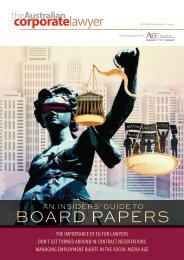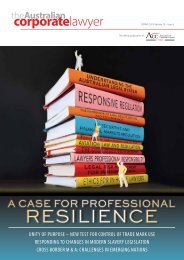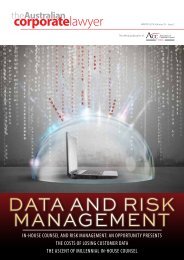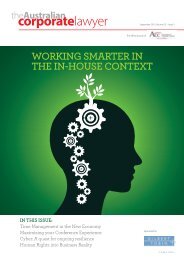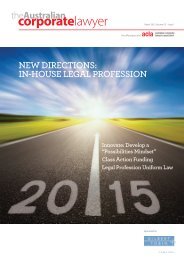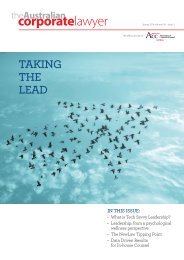Australian Corporate Lawyer - Autumn 2017
Australian Corporate Lawyer is the official publication of the Association of Corporate Counsel (ACC) Australia. The Autumn 2018 issue focuses on 'The Law and Technology' and features a range of articles covering topics including: the future of contracts and; the future of law firms as software companies..
Australian Corporate Lawyer is the official publication of the Association of Corporate Counsel (ACC) Australia. The Autumn 2018 issue focuses on 'The Law and Technology' and features a range of articles covering topics including: the future of contracts and; the future of law firms as software companies..
Create successful ePaper yourself
Turn your PDF publications into a flip-book with our unique Google optimized e-Paper software.
acla.acc.com<br />
Australia has become the jurisdiction outside<br />
the United States in which a company is most<br />
likely to face a class action.<br />
• There has been a spike in shareholder<br />
class actions in recent years. This spike is,<br />
however, wholly attributable to multiple<br />
claims in respect of the same conduct.<br />
• The renaissance of product liability cases<br />
has continued. Although initially driven by<br />
medical devices and pharmaceutical claims,<br />
the recent trend has been driven by claims<br />
in the automotive industry.<br />
• The number of natural disaster class<br />
actions, specifically flood and fire cases,<br />
continues to grow.<br />
• Although there has been a slight dip<br />
in consumer claims in recent years,<br />
they remain fertile ground for class<br />
action promoters.<br />
Blackmail settlements<br />
are not common<br />
The vast majority of class actions are settled,<br />
but almost one-third are dismissed or<br />
discontinued with no money changing<br />
hands. This suggests that so-called ‘blackmail<br />
settlements’ (companies paying to settle<br />
unmeritorious claims) are not as common as<br />
some suggest.<br />
Australia is a regional outlier<br />
Class action activity in Australia has not been<br />
mirrored in other parts of the region or the<br />
rest of the world. Indeed, it is often said that<br />
Australia has become the jurisdiction outside<br />
the United States in which a company is most<br />
likely to face a class action.<br />
Representative and group actions in various<br />
forms are slowly gaining traction in New<br />
Zealand, Hong Kong, China and Singapore<br />
– often without the benefit of a formal class<br />
actions regime. In Japan, as is the case in<br />
many European jurisdictions, class actions<br />
are limited to claims brought by registered<br />
consumer organisations.<br />
Class actions in those jurisdictions are not<br />
currently seen as presenting the same<br />
business opportunities for lawyers and funders<br />
as in Australia. The most likely places for that<br />
to change in the medium term are Hong Kong<br />
and New Zealand.<br />
What does the future hold?<br />
The <strong>Australian</strong> class actions landscape is at an<br />
important crossroads. While increasing filings<br />
have been a cause for concern for some time,<br />
the checks and balances built into the system<br />
have prevented filings from surging out of<br />
control. That remains the case for the moment,<br />
however there are signs that the market may<br />
be changing in a way that will result in a<br />
continued increase in both class action filings<br />
and more speculative claims.<br />
Those signs include:<br />
• The number of new law firms looking<br />
to bring class actions, and to bring class<br />
actions that compete with existing claims,<br />
is indicative of the increasing effect of<br />
lawyer entrepreneurialism in the class<br />
action market. All indicators are that this will<br />
become an even more significant factor in<br />
the years to come.<br />
• The fact that the <strong>Australian</strong> litigation<br />
funding market is largely unregulated and<br />
that it has become accepted that funders<br />
will be involved in making commercial<br />
decisions in respect of the class actions they<br />
fund is making Australia an attractive target<br />
for funders around the world. Although<br />
regulation of funders was recommended<br />
by the Productivity Commission, as<br />
time passes without any indication that<br />
that recommendation will be adopted,<br />
<strong>Australian</strong> class actions are becoming more<br />
and more attractive to offshore funders.<br />
• What’s more, funders are seeking orders<br />
from the courts that would see them<br />
receive a commission from the total amount<br />
recovered in a class action, and not just<br />
from the class members who have signed<br />
funding agreements through a ‘book build’<br />
process. This approach has been recently<br />
approved by the Full Federal Court, but not<br />
in the form sought by the funders. Rather<br />
than locking in a funding commission from<br />
an early point in the proceeding, the Court<br />
has retained the power to approve the<br />
commission rate at a later stage and has<br />
suggested (at least in the case before it) that<br />
it would make the aggregate commission<br />
subject to a cap. We are yet to see how this<br />
will impact the funding arrangements and<br />
conduct of future matters, but the ability<br />
to do away with the book-build phase may<br />
result in a race to be first to file – which, in<br />
turn, will result in class actions being filed<br />
before they are properly investigated (and<br />
therefore to more speculative class actions<br />
being filed).<br />
• These issues would, of course, be<br />
compounded if lawyers are permitted to<br />
charge contingency fees. The opportunity<br />
for lawyers to be remunerated by reference<br />
to a percentage of the outcome is likely<br />
to make class actions an even more<br />
attractive proposition for entrepreneurial<br />
plaintiff lawyers and will most likely result<br />
in even more firms looking to get a slice<br />
of the action. Moreover, the availability of<br />
contingency fees is likely to also encourage<br />
a race to be first to file.<br />
Depending on how these trends and issues<br />
develop, the complexion of the class actions<br />
landscape may change significantly in the<br />
coming years. This has the potential to<br />
significantly increase class action risk for<br />
<strong>Australian</strong> companies. Some of that risk could<br />
be moderated by legislative reform - however,<br />
at this stage, all legislative reform in this space<br />
has been directed at facilitating class actions<br />
and litigation funding on the basis that both<br />
facilitate access to justice. It is likely to take<br />
overwhelming evidence that the effects of<br />
lawyer and funder entrepreneurialism have<br />
completely overshadowed the objectives of<br />
the class action regimes before parliament will<br />
act to rein things in.<br />
Ross and Jenny co-authored Allens' report<br />
entitled Class Action Risk 2016, which provides<br />
a framework for a holistic and data-based<br />
assessment of class action risk. The report can<br />
be downloaded from: http://www.allens.com.<br />
au/pubs/class/papclass19aug16.htm<br />
VOLUME 27, ISSUE 1 – AUTUMN <strong>2017</strong><br />
35



